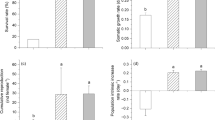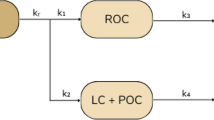Abstract
The filtration rate of Daphnia galeata was determined in in situ experiments in Bautzen Reservoir and in laboratory experiments, where daphnids were exposed to filtrates that previously contained either natural phytoplankton or cultured eukaryotic algae (Scenedesmus obliquus or Asterionella formosa), respectively. Individual filtration rate (FR) was measured using fluorescent beads, taking into account ingested beads in the gut only. Compared to heated control treatments (100 °C), dissolved compounds released by the nutritious cultured algae during the preconditioning phase or by the natural phytoplankton assemblages from Bautzen Reservoir strongly reduced the filtration rate of D. galeata (down to 60%). Heating deactivated these dissolved compounds. A significant correlation was found between primary production measured in situ and the reduction of FR in the filtrate of reservoir water, indicating that extra-cellular products released during photosynthesis triggered the reduction of the filtration rate. The ratio of ingested to collected beads was used to quantify the proportion of food, which was not only collected but passed the mouth of D. galeata. The ratio of ingestion to collection was compared between filtered and unfiltered reservoir water both media identical with respect to the concentration of dissolved compounds, whereas other factors (e.g. food concentration, temperature, filtration rate) were different. The changes in this ratio between filtered and unfiltered reservoir water suggest that D. galeata is capable of a chemosensory control of the ingestion behaviour by detecting external metabolites.
Similar content being viewed by others
References
Benndorf, J., 1987. Food webmanipulation without nutrient control: a useful strategy in lake restoration? Schweiz. Z. Hydrol. 49: 234–248.
Benndorf, J., 1995. Possibilities and limits for controlling eutrophication by biomanipulation. Int. Rev. ges. Hydrobiol. 80: 519–534.
Björnsen, P. K., 1988. Phytoplankton exudation of organic-matterwhy do healthy cells do it? Limnol. Oceanogr. 33: 151–154.
Böing, W. J., A. Wagner, H. Voigt, T. Deppe & J. Benndorf, 1998. Phytoplankton responses to grazing by Daphnia galeata in the biomanipulated Bautzen Reservoir. Hydrobiologia 389: 101–114.
Burns, C.W., D. J. Forsyth, J. F Haney, M. R. James, W Lampert & R.D. Pridmore, 1989. Coexistence and exclusion of zooplankton by Anabaena minutissima var. attenuata in Lake Rotongaio, New Zealand. Arch. Hydrobiol. Beih. Ergebn. Limnol. 32: 63–82.
Crowley, P. H., 1973. Filtering rate inhibition of Daphnia pulex in Wintergreen Lake water. Limnol. Oceanogr. 18: 394–402.
Dawidowicz, P., 1990. Effectiveness of phytoplankton control by large-bodied and small-bodied zooplankton. Hydrobiologia 200/201: 43–47.
Decho, A. W., K. A. Browne & R. K. Zimmer-Faust, 1998. Chemical cues: Why basic peptids are signal molecules in marine environments. Limnol. Oceanogr. 43: 1411–1417.
Dehn, M., 1931. Untersuchungen über die Verdauung bei Daphnien. Z. Vergl. Physiol. 13: 334–358.
DeMott, W. R., 1986. The role of taste in food selection by fresh water zooplankton. Oecologia 69: 334–340.
DeMott, W. R., 1993. Hunger-dependent food selction in zooplankton. In Hughes, R. N. (Ed), Diet Selection. Blackwell Scientific Publications, Oxford: 102–123.
Deppe, T., K. Ockenfeld, A. Meybohm, M. Opitz & J. Benndorf, 1999. Reduction of Microcystis blooms in a hypertrophic reservoir by a combined ecotechnological strategy. Hydrobiologia 408/409: 31–38.
Fogg, G. E., 1983. Ecological significance of extracellular products of photosynthesis. Bot. mar. 26: 3–14.
Forsyth, D. J., J. F. Haney & M. R. James, 1992. Direct observation of toxic effects of cyanobacterial extracellular products on Daphnia. Hydrobiologia 228: 151–155.
Geller, W., 1975. Die Nahrungsaufnahme von Daphnia pulex in Abhängigkeit von der Futter-konzentration, der Temperatur, der Körpergröße und dem Hungerzustand der Tiere. Arch. Hydrobiol. Suppl. 48: 47–107.
Hama, T. & N. Handa, 1987. Pattern of organic matter production by natural phytoplankton population in eutrophic lake. 2. Extracellular products. Arch. Hydrobiol. 109: 227–243.
Haney, J. F., 1971, An in-situ method for measurement of zooplankton grazing rates. Limnol. Oceanogr. 16: 971–977.
Haney, J. F., 1993. Environmental control of diel vertical migration behaviour. Arch. Hydrobiol. Beih. 39: 1–17.
Haney, J. F. & D. J. Hall, 1973. Sugar-coated Daphnia: A preservation technique for Cladocera. Limnol. Oceanogr. 18: 331–333.
Haney, J. F., D. J. Forsyth & M. R. James, 1994. Inhibition of zooplankton filtering rates by dissolved inhibitors produced by naturally occurring cyanobacteria. Arch Hydrobiol. 132: 1–13.
Haney, J. F., J. J. Sasner & M. Ikawa, 1995. Effects of products released by Aphanizomenon flos-aquae and purified saxitoxin on the movements of Daphnia carinata feeding appendages. Limnol. Oceanogr. 40: 263–272.
Hayward, R. S. & D. N. Gallup, 1976. Feeding, filtering and assimilation in Daphnia schoedleri Sars as affected by environmental conditions. Arch. Hydrobiol. 77: 139–163.
Hessen, D. O. & E. Van Donk, 1993. Morphological changes in Scenedesmus induced by substances released from Daphnia. Arch. Hydrobiol. 127: 129–140.
Kamjunke, N., A. Benndorf, C. Wilbert, M. Opitz, J. Kranich, M. Bollenbach & J. Benndorf, 1999. Bacteria ingestion by Daphnia galeata in a biomaipulated reservoir: a mechanism stabilizing biomanipulation. Hydrobiologia 403: 109–121.
Köthe, A., V. Faltin, N. Kamjunke & J. Benndorf, 1997. The structure-forming impact by zooplankton on phytoplankton in a whole-lake biomanipulation experiment. Verh. int. Ver. Limnol. 26: 712–714.
Lampert, W., 1978. Release of dissolved organic carbon by grazing zooplankton. Limnol. Oceanogr. 23: 831–834.
Lampert, W., 1981. Inhibitory and toxic effects of blue-green algae on Daphnia. Int. Rev. ges. Hydrobiol. 66: 285–298.
Lampert, W., 1997. Nahrungskettenmanipulation: Die Rolle von Kompensationsmechanismen für Top-down-Prozesse. Laufener Seminarbeitr. 3: 39–46.
Larsson, P. & S. Dodson, 1993. Chemical communication in planktonic animals (invited review). Arch. Hydrobiol. 129: 129–155.
Lauren-Määttä, C., O. Kleiven & J. Kiviranta, 1997. Horizontal distribution of Daphnia pulex in response to toxic and non-toxic algal extracts. J. Plankton Res. 19: 141–148
Matveev, V., 1993. An investigation of allelopathic effects of Daphnia. Freshwat. Biol. 29: 99–105.
McMahon, J. W. & F. H. Rigler, 1965. Feeding rate of Daphnia magna Straus in different foods labelled with radioactive phosphorus. Limnol. Oceanogr. 10: 105–113.
Murray, A. G., 1995. Phytoplankton exudation: exploitation of the microbial loop as a defence against algal viruses. J. Plankton Res. 17: 1079–1094.
Ostrofsky, M. L., F. G. Jacobs & J. Rowan, 1983. Evidence for the production of extracellular herbivore deterrents by Anabaena flos-aque. Freshwat. Biol. 13: 501–506.
Porter, K. G., 1975. Viable gut passage of gelantinous green algae ingested by Daphnia. Verh. int. Ver. Limnol. 19: 2840–2850.
Porter, K. G., J. Gerritsen & J. Orcutt, 1982. The effect of food cocentration on swimming patterns, feeding behavior, ingestion, assimilation and respiration by Daphnia. Limnol. Oceanogr. 27: 935–949.
Pratt, R., J. F. Oneto & J. Pratt, 1945. Studies on Chlorella vulgaris. X. Influence of the age of the culture on the accumulation of chlorellin. Am. J. Bot. 32: 405–408.
Ryther, J. H., 1954. Inhibitory effects of phytoplankton upon the feeding of Daphnia magna with reference to growth, reproduction and survival. Ecology 35: 522–533.
Shapiro, J. & D. I. Wright, 1984. Lake restoration by biomanipulation: Round Lake, Minnesota, the first 2 years. Freshwat. Biol. 14: 371–383.
Sommer, U., Z. M. Gliwicz, W. Lampert & A. Duncan, 1986. The PEG-model of seasonal succession of planktonic events in fresh waters. Arch. Hydrobiol. 106: 433–471.
Speas, D. W. & W. G. Duffy, 1998. Uptake of dissolved organic carbon (DOC) by Daphnia pulex. J. Freshwat. Ecol. 13: 457–463.
Sundh, I., 1992. Biochemical composition of dissolved organic carbon derived from phytoplankton and used by heterotrophic bacteria. Appl. envir. Microbiol. 58: 2938–2947.
Viner, A. B., 1984. Laboratory effects of light and temperature on the uptake of nutrients by Lake Rotongaio phytoplankton. New Zealand J. mar. Freshwat. Res. 18: 323–340.
Vollenweider, R. A. (ed.), 1969. A Manual on Methods for Measuring Primary Production in Aquatic Environments. IBPHandbook, No. 12, Blackwell Scientific Publications, Oxford: 213 pp.
Wiedner, C. & E. Vareschi, 1995. Evaluation of a fluorescent microparticle technique for measuring filtering rates of Daphnia. Hydrobiologia 302: 89–96.
Zehnder, A. & P. R. Gorham, 1960. Factors influencing the growth of Microcystis aeruginosa (Kuetz). Can. J. Microbiol. 6: 645–660.
Author information
Authors and Affiliations
Rights and permissions
About this article
Cite this article
Wagner, A., Kamjunke, N. Reduction of the filtration rate of Daphnia galeata by dissolved photosynthetic products of edible phytoplankton. Hydrobiologia 442, 165–176 (2001). https://doi.org/10.1023/A:1017538223689
Issue Date:
DOI: https://doi.org/10.1023/A:1017538223689




